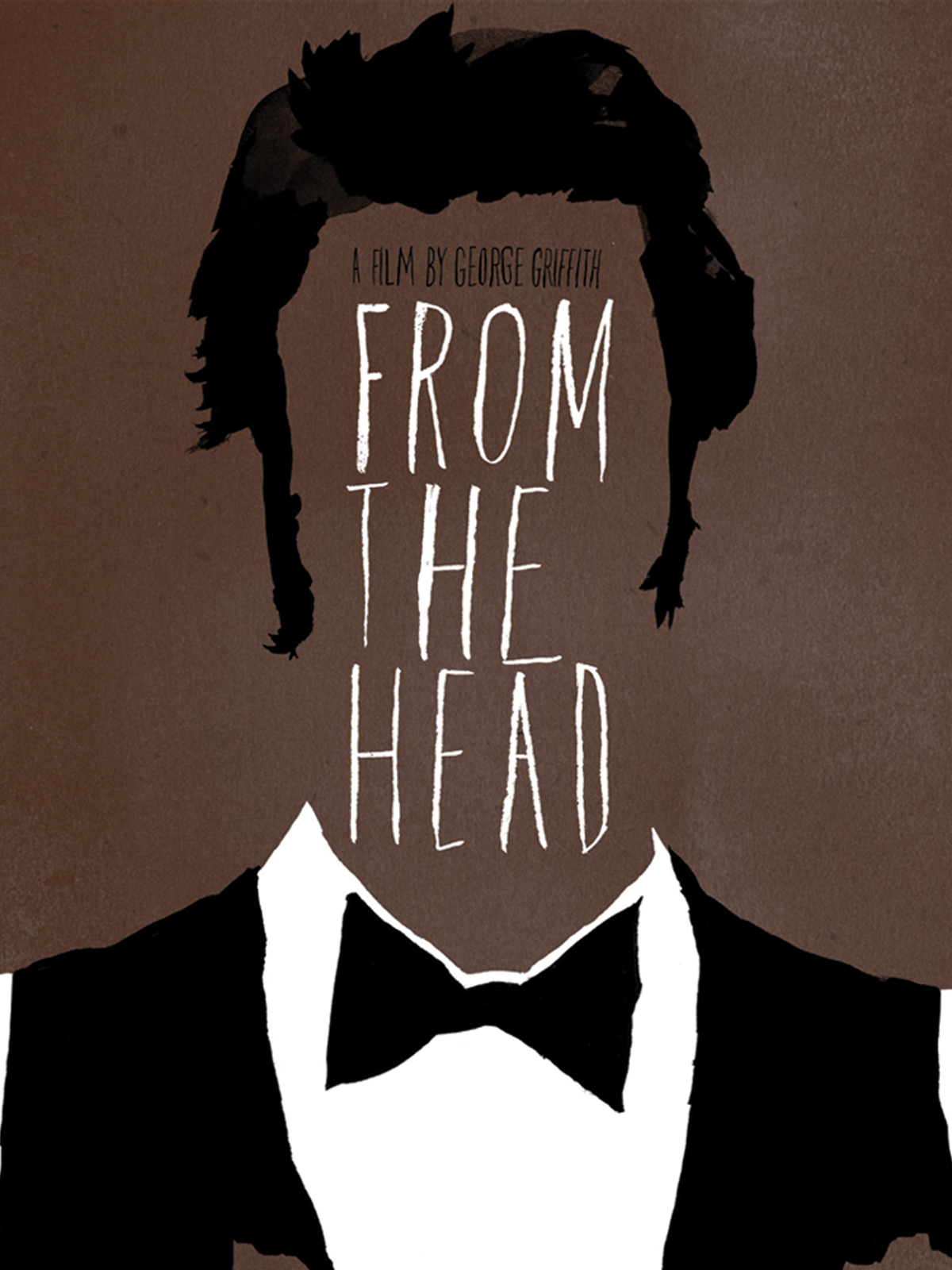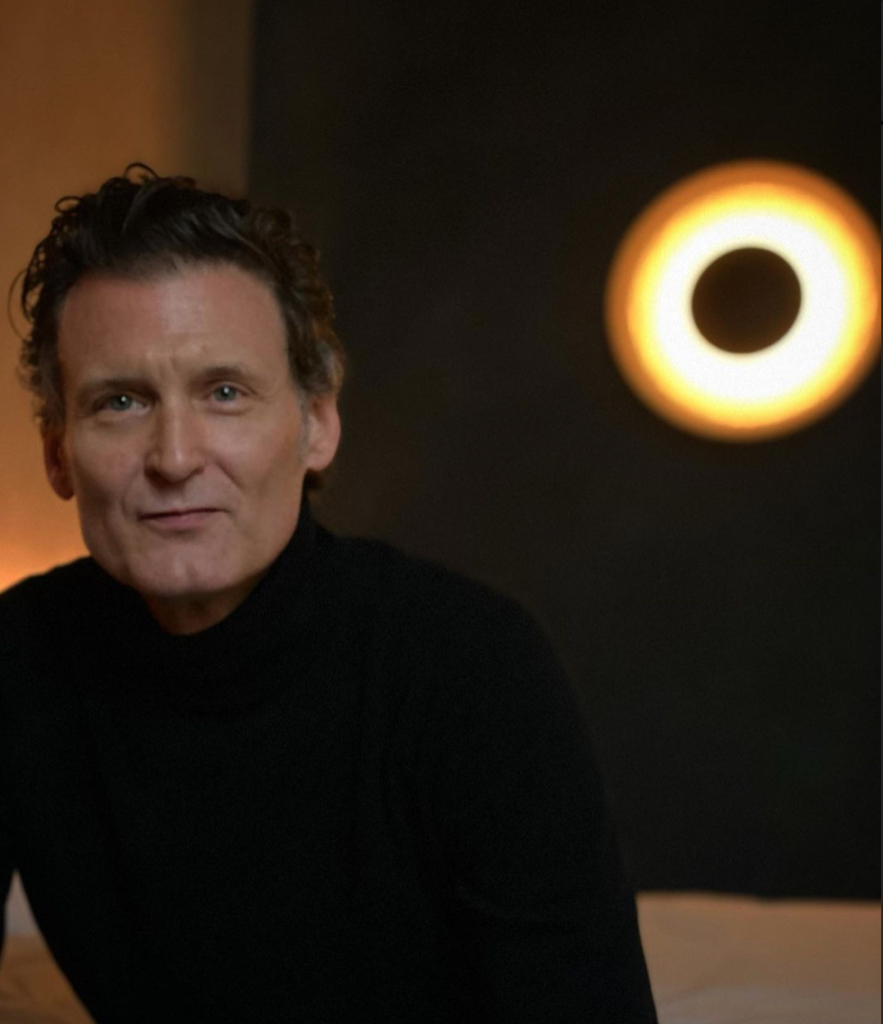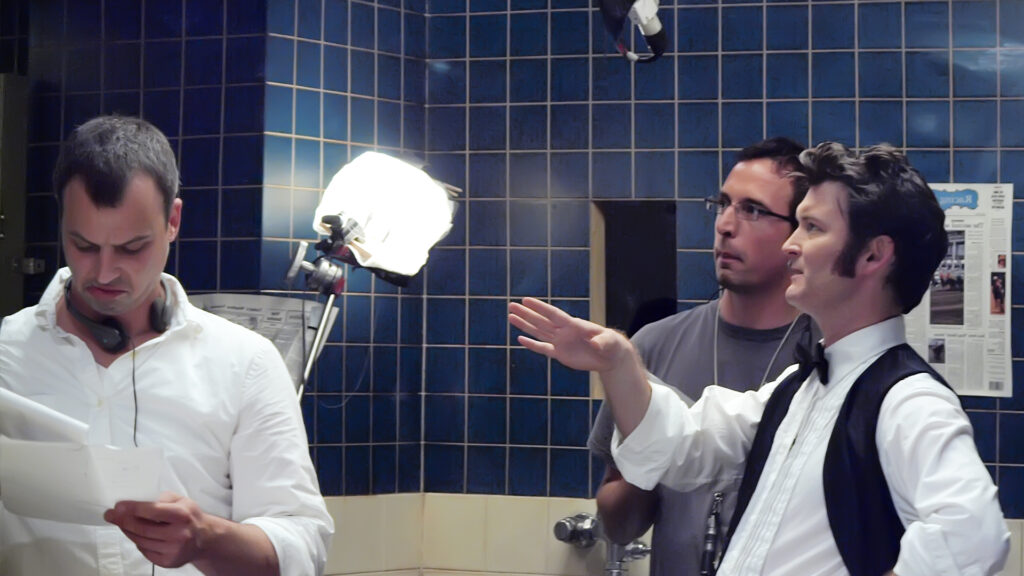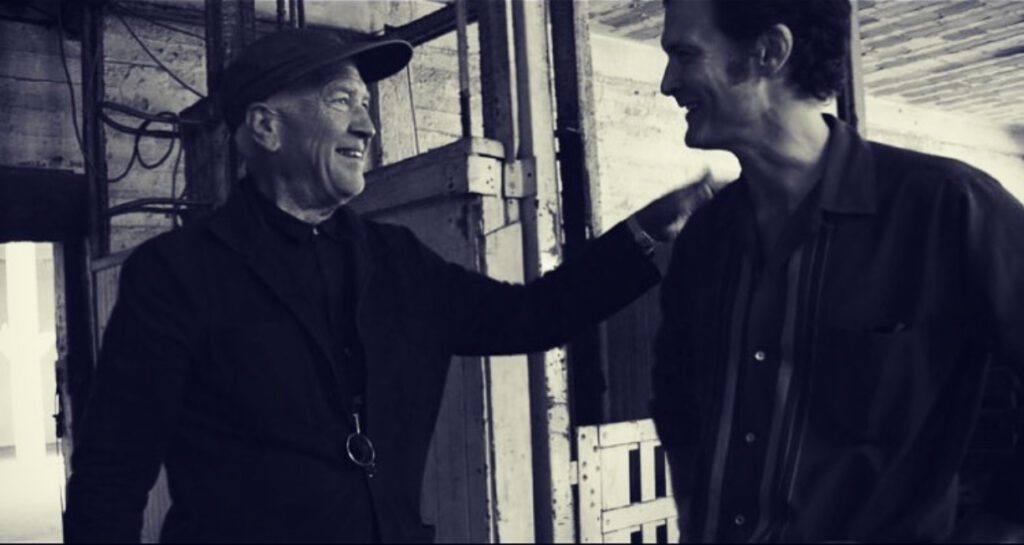Only for the Good Guys | Talking From The Head with George Griffith
Interviews

By William Boyle
George Griffith’s underrated directorial debut, From The Head, was released in 2011. After Griffith’s memorable turn as Ray Monroe in David Lynch’s Twin Peaks: The Return, a new audience found his film. It’s screening on 35mm for the first time ever in Dallas, on Wednesday, May 31st at 9:30 pm CST as part of the incredible lineup for the Texas Theatre’s David Lynch retrospective. Griffith will be in attendance, participating in a post-screening Q&A moderated by Scott Ryan of Blue Rose Magazine. Griffith and other folks from the Lynch universe will be hanging out for the run of the retrospective.
From The Head is set in New York City in the 1990s. Griffith, drawing on his own experiences as a veteran strip-club bathroom attendant, stars as Shoes (named for the wingtips he wears), a bathroom attendant at a Times Square strip club. His small world consists of gleaming tiled walls, a slick routine, noise and action on the other side of the door, drunks stumbling in and out, long shifts, big tips, and free shots. The bathroom he watches over functions more as an office: a place where people come to confess and complain, dream aloud, and spill secrets. They post up at the urinal or sink or hide out in the stall instead of sitting across from some arrogant doctor. Shoes is calm and observant and enigmatic, part therapist and part hustler. He’s celebrating his third anniversary working at the club, looking for his own answers, thinking about the future, and yo-yoing his way through a typical night of drama. Combining the indie spirit of Jim Jarmusch and Richard Linklater with the existential minimalism of Samuel Beckett, From The Head unfolds as a character study full of striking details. Co-starring Matthew Lillard, Ahna O’Reilly, and Jon Polito, the film is built on brief encounters, a prescient look at community during an era when the way we communicate was beginning to change.
Griffith and I go back almost ten years now. He read my first novel and got in touch about the possibility of adapting it, and that was the beginning of a friendship and creative partnership I value immensely. When we hang out and talk, we’re very much on the same page in terms of the art that’s had the biggest impact on us—Lynch, Tom Waits, Nick Cave, John Cassavetes, Gena Rowlands, Martin Scorsese, Abel Ferrara, Jim Jarmusch, Sam Shepard . . . the list goes on and on. It was a pleasure to talk to him about the Texas Theatre screening. His place in the Lynch universe is solidified, no doubt, and I hope a larger audience discovers From The Head.
WILLIAM BOYLE: How does it feel to have your movie screening as part of a David Lynch retrospective? To be affiliated with an artist you’ve idolized for so long?

GEORGE GRIFFITH: It’s really a dream come true on so many levels. As a filmmaker, just having David acknowledge my existence, let alone give my movie the kind of praise he did, is incredible. Beyond all that, to be included in this program feels wonderful. My father was the cinephile who would take me out of school to go see Kurosawa movies when I was thirteen. He turned me on to film and guided me, in an advanced way, to look at things, be thoughtful, be open, and appreciate all the effort and labor put into film and cinematography and all this stuff. If he could see that my movie appears on this bill between movies by Spielberg [The Fabelmans also screens as part of the retrospective] and Lynch, I think it would just be such a kick. I’ve been letting that wash over me.
It’s easier now to recognize how my primary influences are present in From The Head. I wasn’t as conscious of that when the film was first released, but I’ve become more aware over the last ten years. Like I said, I grew up in this film environment. My father had his favorite directors, and they became my favorite directors. Kubrick and Kurosawa were huge in my house. When I got to high school, we had a good Kim’s Video-type place in Philly. David became my favorite director. I really fell in love with Jim Jarmusch’s work, too. I feel like those two are sort of the parents of From The Head. By the time I was doing it, my acting philosophy and viewpoints had been fueled predominantly by John Cassavetes’s films. I felt like his movies were the rawest and most authentic. But David’s worlds would be really small, and so much would be happening within them, like in Eraserhead and Blue Velvet. That was something that really inspired From The Head.
WB: I want to talk a little more about the origins of From The Head. It’s based on a job you had as an attendant in a Times Square strip club bathroom. I know you also have a lot of musical and literary influences, as well as film. What specifically influenced the script? Did you always know you were going to direct it?
GG: Yes, I felt very strongly that if I was going to get From The Head made, I wanted to direct it. When I was trying to get it produced, there was certainly an easier, faster path to getting it done if I’d given up my role or let someone else direct it. At one point, I was asked to give a list of potential directors. I said there weren’t any, so they asked me just to name one. I was like, Oh, man, this is one of those tricky things. What if they get that one person I name? I always knew I was going to direct. That’s why I wrote it sparsely. The screenplay is primarily dialogue.
I recorded a lot of the conversations I had in the bathroom when I was working at the club, and I would transcribe them when I got home. I taped this little Agent Cooper cassette recorder into the inside of my vest. There was this guy who’d come into work after me, and I asked him to wear it, too. I’d take my tape out, put a new one in, and tell him, “Only for the good guys. I’ve only got a couple of tapes.” Afterward, we’d swap, and I’d listen to his tapes. I knew all my regulars, but I’d be like, Whoa, man, the insanity just never ends here.
I read nonstop when I was in the bathroom—a lot of pulp fiction, old school and new. Of course, Tom Waits was a big influence on me. For the tone of it; for the parade that was going on, the non-judgmental celebration of those kinds of characters. Similar to Bukowski, but Waits is a little more poetic and funnier. I just wanted to honor these characters and never judge them. I could hear all of them. There were so many guys. I didn’t put all of them in the movie, but I never forgot their voices, and they delivered themselves in a lot of ways.
WB: What about playwrights? It’s pretty much a single-location movie. Knowing you wanted to direct it and keep it small, I imagine you drew some inspiration from the theater. When I think of the single-location films I love, they’re generally based on plays.
GG: Maybe not so on the nose as far as single locations. But I’d been a real student and a real fan of Sam Shepard. He was the best for me. He’d write these characters that could be an archetype and a real person at the same time. Amid all the mania, they still had this core, this distilled desire for love and connection. Those are the greatest characters. That’s what’s burning in them. They’re falling in love or looking for love or falling out of love. But love is the thing. With Shepard, there’s a lot of adventure in how people communicate. And there’s a freedom to it, like in David’s work. There’s that quote of David’s where he says something like, “I don’t know why people expect art to make sense. Because life doesn’t make sense.” I appreciate that.

WB: What was the making of the movie like? You play the main character, Shoes, but it’s essentially an ensemble movie built on Shoes’s encounters with a parade of visitors to the bathroom. How was it working with all those different actors?
GG: Sixty-two or sixty-three guys come through the bathroom. That’s a lot of personality. I put a lot of care into it. The casting director, Russell Boast, brought people in. I didn’t look at resumes or get pressured into casting people because of a show they’d just been on, a movie they were in, who they were related to, or anything like that. I just watched people. When I felt like they were the one, they were the one.
That’s a critical part of why it went so well. I wasn’t going to be afforded an extended period to establish familiarity or a relationship—to get to know somebody—because each actor was only able to come in for a day or two. Also, I shot in sequence, which is very unusual for a film. I asked to do this mostly because the story takes place in real time. Also, for my performance—for tracking my performance. Every day a new person would come in, and it was beautiful. I had to reset myself and tell them how grateful I was to be able to be making this film, how grateful I was to have them there. Then I would have to give them the speech about how, on the first day, I shot too much film, and, since then, I’ve only been able to have one take of almost everything. So, mostly my performance became one take. If they checked the gate and everything was good, we usually went with it. We would shoot in one direction, and I’d tell them, “We’ll rehearse, and we’ll get it so we’re feeling good, and then we’ll shoot it.” It was electric. It was kind of charged. Some of those people had never shot on film, and they gave me a lot of trust. I’d shoot all in one direction in the morning. Later in the day, we’d have to put the wall on, take the other wall off, and shoot in the other direction. So, I would basically do all their coverage or my coverage in the morning, then the opposite way. We could usually get through two scenes that way. In the afternoons, we’d do pickups from behind the newspapers—and occasionally the mirror—but that was the lion’s share of the shots. There was also a ceiling, and there’s not often a ceiling on sets. Since I was able to light it and have it set like that, it all stayed that way. That’s how we did it. I couldn’t have been more pleased with everybody. There were a lot of people from the theater and a lot of people from the East Coast. I thought they were all so brilliant. I was a straight man in that movie. They were the characters. I always thought of From The Head as a road movie—you know, the road was going by—and that helped me.
WB: It’s so ambitious in terms of how many people pass through the bathroom—it’s reminiscent of an Altman ensemble. Do you have any other favorite stories from the shoot?
GG: When things went well, there was no time for anything other than shooting it. Something funny is that my shoes had platforms on them. They were the same shoes I wore in the bathroom when I worked there years before. I hadn’t worn them in a long time. When I wore them the first day . . . I don’t know what happened, but I was limping, and my back was hurting from wearing these platforms all day. The producers brought in a chiropractor to work on me. They said, “Hey, those shoes are just not OK. I can’t believe you ever wore them, but they’re just not OK.” And I was like, “Well, I’ve gotta wear the shoes.” And they said, “George, you don’t see the shoes in the entire movie.” And I said, “I know they’re on me, and I gotta wear them.” That was one of the first of many times I stuck to my guns. So, I did, in fact, wear my shoes for every single shot of the movie, even though they never appear onscreen.
WB: One of the things I responded to about the movie when I first watched it—and still really respond to—is that it’s set in the 1990s. It came out in 2011, but it really feels like a ‘90s indie movie in all the best ways. How much were you thinking about that when you were writing and shooting it? Also, now that some time has passed, how do you think about it as a movie that marks the end of an era? You shot on film, but just as digital was becoming the norm and we were nearing the beginning of the streaming age.
GG: I deliberately set it in the ‘90s, and I did think of it as a ’90s movie. In many ways, the ’90s were my favorite decade for movies, certainly among the decades I was alive for. When I was growing up, the ’70s were where it was at, but the ’90s just became this really unbelievable decade for independent film. It became a time when auteurs were getting money to make movies and shoot movies on film. And it wasn’t yet predicated on sales agent algorithms and things like that. Independent spirit was valued. You had all these actors and directors who were the kings and queens of it. There was also room for something totally new all the time. It was pre-digital. The only way you made a movie was on film. Film is beautiful. I think it’s the most amazing way to see something, especially something that ages a little bit and has some wear on it. I love that.

David is a global cinematic luminary, but he was always an independent filmmaker. Jarmusch, too. It was inspiring that you could be a visionary and an auteur—that you could reach a larger audience outside of the United States and be the kind of filmmaker who would represent American cinema. In terms of my philosophy and a lot of the things I stuck to while making From The Head, they were based on things that I’d heard Lynch and Jarmusch discuss frequently. When I think about the ’90s and the films that influenced me the most, it starts with Goodfellas. It’s rock-and-roll and art and real people. Abel Ferrara’s King of New York was another big one. My Own Private Idaho. Sean Penn’s The Indian Runner. There was all this stuff where I’d be like, “That’s my favorite movie. No, that’s my favorite movie.” I still watch Buffalo ’66 and go, “Man, that’s the way to make a movie.” My desire was just to make something I loved and would always to be proud of. 1995 was when I was discovering all these films and all these filmmakers, and I felt very charged creatively. By the time I got to make From The Head, I could have been beaten down. But I wasn’t, maybe because I’m a little crazy. I could go back to that energy source. Also, 1995 was when I worked in the bathroom. There were no cell phones, which I don’t like in movies. I don’t like what Google and cell phones do to characters in movies. I also felt like, if I set the movie in the ’90s, I could be an authority on what was real, the way things were. I’m very pleased to have From The Head thought of as a ’90s movie.
William Boyle is the author of the novels Gravesend, The Lonely Witness, A Friend Is a Gift You Give Yourself, City of Margins, and Shoot the Moonlight Out. His novella Everything Is Broken was published in Southwest Review Volume 104, numbers 1–4. His website is williammichaelboyle.com.
More Interviews
